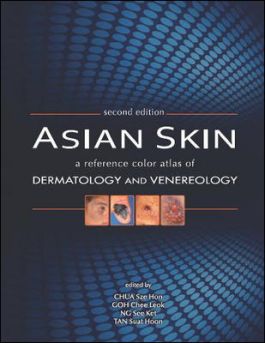The Asian Skin
2nd Edition
9814575003
·
9789814575003
© 2014 | Published: December 23, 2013
Asians are a diverse group of people. They consist of people from South Asia, which includes the subcontinent region of Pakistan, India, and Sri Lanka; South-East Asia, which includes countries such as Singapore, Malaysia, Indonesia, Thailand, and Ph…
Read More
Receive via shipping:
- Colour, print bound version of the complete text
Contents
Preface
Acknowledgements
Contributors
1. Acneiform Disorders
2. Endogenous Eczema
3. Contact Dermatitis and Occupational Dermatoses
4. Papulosquamous Disorders
5. Pigmentary Disorders
6. Cutaneous Infections
7. Pediatric Dermatology
8. Genodermatoses
9. Photodermatoses
10. Immunodermatology
11. Skin Tumors
12. Cutaneous Lymphomas
13. Miscellaneous Cutaneous Proliferative Disorders
14. Cutaneous Manifestations of Systemic Diseases
15. Cutaneous Adverse Drug Reactions
16. Pregnancy Dermatoses
17. Urticaria and Angioedema
18. Pruritic Skin Conditions
19. Hair Disorders
20. Nail Disorders
21. Wound and Skin Ulcers
22. Psychodermatology
23. Cosmetic Dermatology
24. Miscellaneous Dermatoses in Asians
25. Sexually Transmitted Infections and Non-STI Genital Dermatoses
26. Skin Disorders in HIV-infected Persons
Index
Preface
Acknowledgements
Contributors
1. Acneiform Disorders
2. Endogenous Eczema
3. Contact Dermatitis and Occupational Dermatoses
4. Papulosquamous Disorders
5. Pigmentary Disorders
6. Cutaneous Infections
7. Pediatric Dermatology
8. Genodermatoses
9. Photodermatoses
10. Immunodermatology
11. Skin Tumors
12. Cutaneous Lymphomas
13. Miscellaneous Cutaneous Proliferative Disorders
14. Cutaneous Manifestations of Systemic Diseases
15. Cutaneous Adverse Drug Reactions
16. Pregnancy Dermatoses
17. Urticaria and Angioedema
18. Pruritic Skin Conditions
19. Hair Disorders
20. Nail Disorders
21. Wound and Skin Ulcers
22. Psychodermatology
23. Cosmetic Dermatology
24. Miscellaneous Dermatoses in Asians
25. Sexually Transmitted Infections and Non-STI Genital Dermatoses
26. Skin Disorders in HIV-infected Persons
Index
Asians are a diverse group of people. They consist of people from South Asia, which includes the subcontinent region of Pakistan, India, and Sri Lanka; South-East Asia, which includes countries such as Singapore, Malaysia, Indonesia, Thailand, and Philippines; and East Asia, which includes China, Japan, and Korea. In these regions, people with Fitzpatrick skin types III to V predominate.
Dermatoses involving Asians often take on a slightly different clinical appearance from those affecting Caucasians, who predominantly have Fitzpatrick skin types I and II. This is due to the differences in melanin content and its distribution as well as different pigmentary responses following skin inflammation and injury. In addition, inherent genetic differences and unique cultural practices result in a different spectrum of skin conditions seen in Asians.
The first edition of The Asian Skin atlas was published in 2005. In this second edition, more than 95% of the clinical pictures found in the first edition have been refreshed. This new atlas expands on the previous edition by including new conditions within existing chapters as well as adding eight new chapters. Histology of key clinical conditions is now incorporated as well.
This comprehensive atlas of dermatology contains more than 1,400 high quality clinical and histological pictures of dermatoses affecting Asians. Conditions unique to Asians such as nevus of Ota/Ito, Hori's nevus, Ofuji's disease, progressive macular confluent hypomelanosis,cutaneous plasmacytosis, cutaneous amyloidosis as well as conditions with a geographical Asia bias such as cutaneous larval migrans and chronic arsenic poisoning are well illustrated. This compilation will serve as a valuable reference atlas and an essential companion to dermatology textbooks for all dermatologists managing patients of Asian descent.
Dermatoses involving Asians often take on a slightly different clinical appearance from those affecting Caucasians, who predominantly have Fitzpatrick skin types I and II. This is due to the differences in melanin content and its distribution as well as different pigmentary responses following skin inflammation and injury. In addition, inherent genetic differences and unique cultural practices result in a different spectrum of skin conditions seen in Asians.
The first edition of The Asian Skin atlas was published in 2005. In this second edition, more than 95% of the clinical pictures found in the first edition have been refreshed. This new atlas expands on the previous edition by including new conditions within existing chapters as well as adding eight new chapters. Histology of key clinical conditions is now incorporated as well.
This comprehensive atlas of dermatology contains more than 1,400 high quality clinical and histological pictures of dermatoses affecting Asians. Conditions unique to Asians such as nevus of Ota/Ito, Hori's nevus, Ofuji's disease, progressive macular confluent hypomelanosis,cutaneous plasmacytosis, cutaneous amyloidosis as well as conditions with a geographical Asia bias such as cutaneous larval migrans and chronic arsenic poisoning are well illustrated. This compilation will serve as a valuable reference atlas and an essential companion to dermatology textbooks for all dermatologists managing patients of Asian descent.

